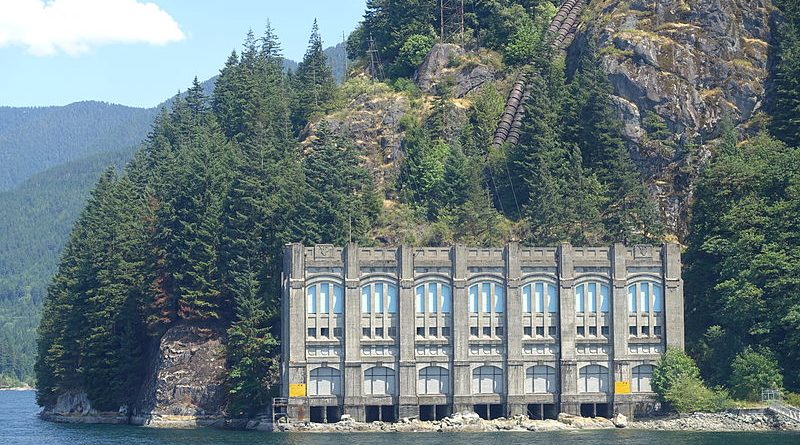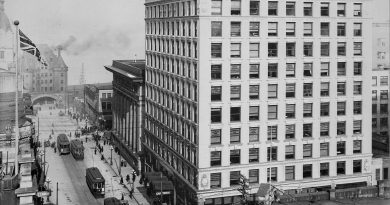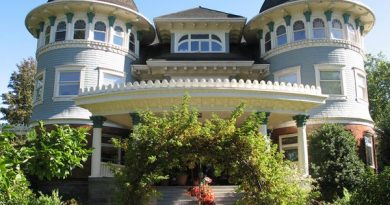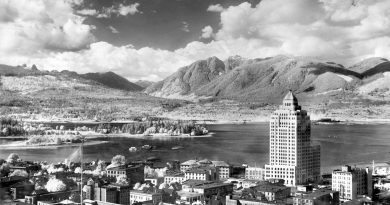A Trip Up Indian Arm
Thursday, July 24, 2008
This was a memorable day. Harvey Oberfeld and I were the guests of Brian Forst aboard Brian’s lively 26-foot Sea Ray, the Thai Dancer, on a trip to the head of Indian Arm, site of the famous Wigwam Inn. After 64 years in this neck of the woods I had never been up Indian Arm. Harve and Brian had both been, often. (One thing we did have in common: all three of us are former broadcasters.)

[Photo: Harvey Oberfeld]
We left the Royal Vancouver Yacht Club’s Coal Harbour station at 1:40,, but before heading to Indian Arm were treated, thanks to Brian, to a leisurely cruise along the eastern half of Burrard Inlet. The expansion to the city’s Convention Centre is well underway and the building makes a dramatic lunge over the water. It’s big: the project is going to triple the Centre’s available space.
One eye-popping episode was a slow drift past the 90-metre-long yacht Ice, a German-built beauty owned by Russian billionaire Suleyman Kerimov. She was moored at the Rogers Sugar Refinery. You can enjoy a look inside this lavish boat—like something from a science fiction movie— here. The Wikipedia article on Kerimov says “He is an enigmatic figure who claims to eschew publicity but advertises a lavish lifestyle in the media.”
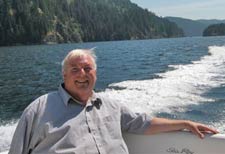
[Photo: Chuck Davis]
The inlet’s waters were choppy, but once we swung north into Indian Arm they smoothed out. At a steady 21 knots (the speed shown on a GPS screen Brian has aboard, a satellite-supported system that can actually show the boat moving over a map of the region) we headed north, Deep Cove on our left, Belcarra on our right. I showed off my knowledge of local history by pointing out the area on the north shore of the inlet where the late novelist Malcolm Lowry worked (in a squatter’s shack) on his novel Under the Volcano. Indian River Road wiggles north for a short distance past Deep Cove, paralleling Indian Arm, but north of road’s end all the people whose houses line the Arm get to them via boat. There are dozens of houses sprinkled along the shore, sometimes by themselves, sometimes in groups of half-a-dozen or more, and some are obviously expensive places. (And, incidentally, I can’t recall seeing a single person in or around those houses.)

[Photo: Harvey Oberfeld]
Because it was a weekday water traffic was light, so we were able to keep up a good pace right to the Inn. It’s owned by the RVYC, and is for members and their guests only. There were just two other boats there, so snuggling up to the pier and securing the Thai Dancer was easy work.
Wigwam Inn was built in 1909, financed by Prussian-born financier Alvo von Alvensleben. He’d come here in 1904 with $4 in his pocket, and five years later was one of Vancouver’s most prominent realtors. You can read more about this fascinating fellow on my web site here. The Inn is three storeys high, but smaller than I had expected. We sat on the verandah and munched on sandwiches we’d brought along, washed down with soft drinks.
While Brian and Harve talked boats with another visiting yachtsman (who was staying overnight with his family on his boat), I wandered through the Inn’s deserted (and somewhat dark and gloomy) rooms where I found, among other things, a Province newspaper clipping on the Inn dated April 9, 1910 that I’ll read more carefully at the library soon, and a copy of the April 15, 1911 register that showed the signatures of two financial titans of the time, John D. Rockefeller and John Jacob Astor. Exactly one year to the day later Astor would be one of the victims of the Titanic tragedy. A lot of famous folk stayed at this place during its heyday. There are two floors of rooms, but this day except for the caretaker’s they appeared to be vacant.
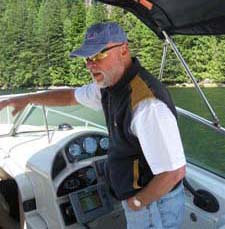
[Photo: Harvey Oberfeld]
I also found—incised for some reason on a stretched piece of leather on one of the Inn’s walls—a proclamation of the sale of the Wigwam to the RVYC on June 23, 1985.
A highlight of the trip back to town was passing two old BC Hydro powerhouses on the eastern shore. One of them has been there for more than a century, and they’re still in use. A Wikipedia article and other sources tell us they’re fed by water from Buntzen Lake, about 150 metres up the hill. That lake, in turn, is replenished through a tunnel by water from the much larger Coquitlam Lake to the east and above Buntzen. Hydro controls virtually all of that Coquitlam Lake water, but the water authorities at Metro Vancouver (formerly known as the GVRD) apparently want more of it for domestic use. They’re talking.

[Photo: Harvey Oberfeld]
Meanwhile, that Wikipedia article continues: “Penstocks direct water down from the lake to the power plants . . . Buntzen No. 1, with an initial capacity of 1,500 kW, was built in 1903 to provide electricity for the Vancouver area. It was upgraded in 1951 to boost capacity to 55,000 kW. Buntzen No. 2 [a stone’s throw north of No. 1] was built in 1914 to supply 26,700 kW of power . . . The stations are unmanned, operated by remote control from a BC Hydro facility atop Burnaby Mountain.” We got close enough to read Vancouver Power Company 1903 on No. 1, but big signs cautioned us from coming too close: apparently sudden outflows of water can occur.
Incidentally, the Buntzen for whom the lake was named is Johannes Buntzen, a Dane who’s called “the grandfather of electricity” in British Columbia. He was the first general manager of the BC Electric Railway.
There was a nice coincidence associated with this trip. The morning mail that very day brought the latest issue of British Columbia History, the quarterly publication of the British Columbia Historical Federation, edited by John Atkin. In it was an article by Janet Nicol on Alvo von Alvensleben and the Wigwam Inn! I brought it along to show my boatmates.
Coming back, we dodged a couple of float planes taking off from the Inlet, then Brian brought us slowly back in to the RVYC station to end a terrific and illuminating day.

